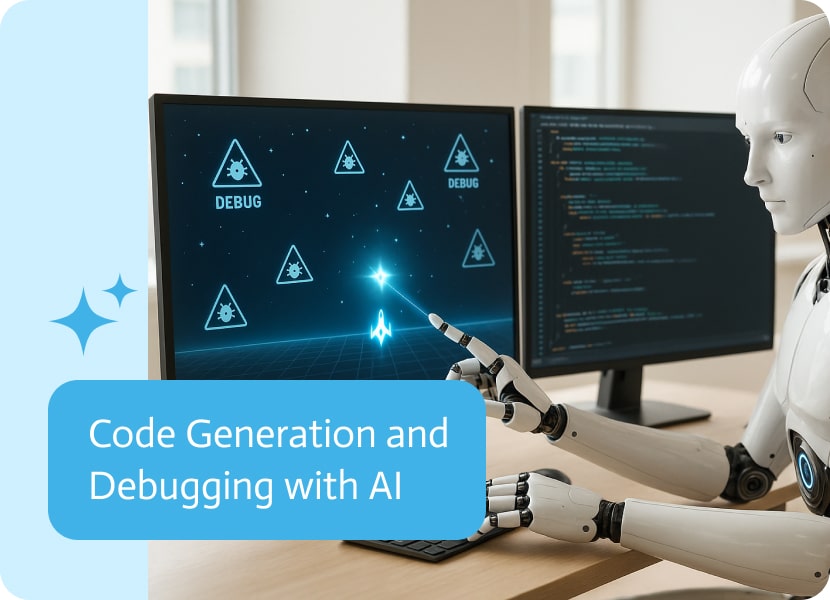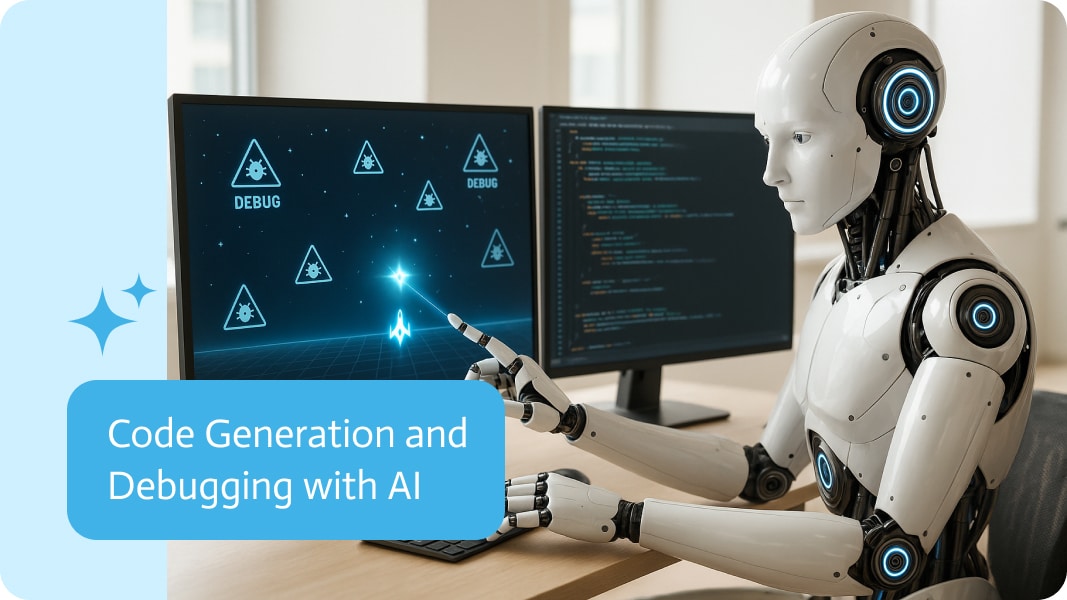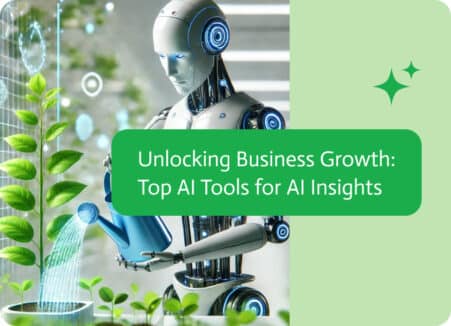

Code Generation and Debugging with AI: A Comprehensive Guide
These capabilities simplify the rapid development of features or prototypes. AI makes it easy to translate requirements into executable code. Furthermore, developers can articulate the functionality they desire, and AI takes care of implementing it down to edge cases and error conditions while following proper conventions. In the earlier stages of design known as prototyping, where optimizing speed and not spending more time than necessary is key, this functionality can be especially useful.
For instance, the request “a function that validates email addresses and returns detailed error messages” would not only require the main validation logic but also integrate sophisticated error handling, input cleaning, and at times several validation methods for selection.
Algorithm Implementation
AI can generate complex algorithms that would take humans hours to implement and debug almost instantaneously. Be it sorting algorithms, implementing data structures, or complex mathematical calculations, optimized code with proper complexity analysis and edge case handling will be taken care of.
Here, the added value does not lie in the time taken but rather in the speed and ability to approach a problem in different ways. Having different approaches enables developers to analyze the solutions and pick the most suitable one for their use case.
Boilerplate and Infrastructure Code
The most apparent advantage AI brings to code generation is the automation of dull, repetitive boilerplate tasks. The setting up of API endpoint logic, database connections, systems such as authentication, and even configuration files can be fully automated. This allows developers to focus on the business logic and solving actual problems instead of dealing with repetitive tasks done during the initial setup.
Innovative Strategies for Debugging
Recognizing Patterns and Root Cause Analysis
Debugging software developed with Artificial Intelligence capabilities uses the analysis of error patterns within specific codebases to not only identify current problems, but also anticipate future detractive bugs systemically. In addition to bug identification, these sophisticated systems are capable of tracing execution paths, analyzing reasons for variables, and identifying possible race and memory leaks before these application issues get into the production stage.
Two essential ideas in software development are code generation and debugging, each of which plays a unique but complementary part in the process of producing usable software.
With pre-measured ingredients, code generation is similar to using a pre-made mix to bake a cake more quickly.
Debugging is similar to figuring out why your cake fell apart in the oven. Was there too much baking powder? Was the oven too hot?
The landscape of software development has shifted dramatically over the past few years. We previously had to endure lengthy hours of coding and debugging, now, we can do so in mere minutes with new artificial intelligence tools. This shift represents more than just enhanced productivity; it is now altering how developers tackle issues around problem-solving and software architecture.
The Status of AI-Assisted Software Development
Modern AI development tools have come a long way from basic autocomplete features. By using natural language commands, today’s tools are advanced enough to compose entire functions, debug complex issues, and even design whole applications. These systems have the capability to interpret context, adhere to coding styles, and have astounding mastery across multiple languages.
These tools’ functionality stems from being powered by large-scale language models trained on documents, forks, and Git repositories containing billions of lines of code. Based on this extensive training, AI systems are trained to identify patterns and best practices to offer solutions that stand up to, or even exceed the quality dynamically generated by humans.
Code Generation Capabilities and Applications
The level of diagnosis that often unveils sophisticated interconnections is often very complex. An example is the AI debuggers being able to identify that particular performance problems within some module stems from poor database queries that get initiated by multi-tiered user interface interactions.
Unit Tests Automation
The modern AI era has brought about tools that generate elaborate suites of tests that have almost every edge case. Tests are also a step ahead with the inclusion of upper and lower limb verification checking and combination checking of integration tests.
Development was so far in the art of software testing and high-level development was so automated like the generated tests that often uncovered bugs unknown before that most developers overlooked. With the diving into unorthodox input combinations and execution paths testing, development was able to unearth bugs that were very normed to only surface in operational environments.
Resolving Mistakes on the Go or in Real Time
In runtime error attempts to using some AI powered software, a few specialized systems have adapted the practice of monitoring running applications that use eye level suggestion of changing codes that actually are likely to disturb the ordering an application. These software tools specialize in examining the surrounding context and the exception using the cap method alongside the adopting dominating runtime reasoning approach, they suggest some measures of finer remediation that could disturb the order of underlying code.
This capability goes further than logic errors and performance issues to include operational issues, integration problems, and even bugs. Most of the time, the AI is capable of determining many possible solutions and ordering them according to their chances of success as well as the ease of implementation.
Integration Strategies for Development Teams
Workflow Integration
For successful implementation of AI into a company, it is important to combine it with the existing processes in a development workflow. The most effective techniques involve integrating AI features within tools that developers are already accustomed to, instead of making them learn different systems.
Generate coding tasks within IDEs and VCS units. This enables programmers to create and review code within their standard workflows and trim their version history properly. The goal is to provide AI support in a way that makes it seem as if it has always been a part of the tools that the developers already use.
Code Review and Quality Assurance
It’s vital that some supervision is maintained with AI systems. The review steps are quite different as these are not traditional code reviews. Reviewers need to concern themselves with whether the AI has comprehended the requirements properly, as well as whether the solution complies with system architecture.
To maximize efficiency while maintaining quality, teams need to formulate clear guidelines for AI code review. These rules need to address when AI generation creation is deemed necessary, what steps need to be taken to validate AI-produced codes, and how many transformations a code needs to undergo before being regarded as AI-generated code.
Transferring Knowledge and Making Documentation
AI tools adept at programming can effortlessly create documentation. This includes API documentation, comments, and even architectural decision documents in which the rationale for particular decisions is provided.
This functionality is extremely useful for knowledge transfer within teams. The documentation, which is created by AI allows new developers to quickly gain an understanding of complex systems, as they can navigate through the detailed explanations of functionality and design choices.
Performance Optimization and Scalability
Automated Performance Analysis
AI can evaluate the performance characteristics of code and suggest optimizations without requiring profiling to be done manually. These tools identify bottlenecks, memory wasting, and algorithmic improvements through code analysis as well as execution pattern examination.
Generally, the analysis has much greater optimization potential than human developers. For example, AI may discover that data structure choices in one block of code adversely influence performance in other seemingly unrelated functions, and that performance in those functions would be unrelatedly improved if control structures in that block were altered.
Planning for Scalability
Current AI tools are capable of assessing code and looking for scalability issues. They can also provide suggestions regarding filing and structural enhancements that would sharpen the application before it is put into production. This consists of locating possible bottlenecks, suggesting caching, and developing database optimization techniques.
Preventing scalability problems early in development allows for costly refactorings later on. AI is capable of simulating loads of varying numbers and can determine which components will pose challenges as the user base increases.
Considerations and Best Practices for Security
Vulnerability Evaluation
The scope of AI security analysis is much wider than traditional static analysis tools since they analyze the context of the code and nuanced security vulnerabilities that are not immediately perceived. Such systems can find opportunities for implantation, authentication bypasses, and even privilege escalations that pattern-based tools will not be able to detect.
Such analysis not only takes into account direct vulnerabilities but also security anti-patterns that might pose a challenge while changing or modifying something in the future. These measures are in place to ensure that no security issues pop up after reaching production.
Secure Code Generation
When generating code, modern AI models follow security protocols automatically. Implementation of new features such as the generation of authentication systems now includes adequate password hashing, API endpoints come with ensuring there is validation of inputs, and database retrieval and storage operations are done via set parameters to avert injection threats.
However, AI-generated codes are always bound to receive scrutiny. Most times, generated code is bound to pass every form of security check, but tailored needs for security require one-of-a-kind application provisions, which cannot be, at any point, expected of AI.
Futuristic Feedback and Possible New Features
Development with Context
The next generation of coding with AI tools will have a wider context scope across the entire codebase with the ability to not only comprehend single functions, but whole system architectures. Such understanding will make it possible to implement complex theories for refactoring and suggest architectural improvements that are far more advanced.
Such systems automatically track how codebases have changed over time, learning from decision-making in the past and the consequences that followed, subsequently tailoring suggestions for enhancement in the code’s evolution.
Collaborative AI Programming
Emerging tools enable real-time collaboration between human developers and AI systems. Rather than generating complete solutions independently, these systems participate in the development process as active partners, suggesting improvements, identifying issues, and adapting to developer preferences in real-time.
This collaborative approach combines human creativity and domain expertise with AI’s pattern recognition and generation capabilities, potentially producing better results than either could achieve independently.
Practical Implementation Guidelines
Getting Started
Organizations beginning AI-assisted development should start with low-risk applications like test generation and documentation creation. This allows teams to become comfortable with AI tools while minimizing potential disruption to critical systems.
Initial implementations should focus on augmenting existing processes rather than replacing them entirely. As teams gain experience and confidence, they can gradually expand AI usage to more complex development tasks.
Measuring Success
Success metrics for AI-assisted development should include both quantitative measures like development speed and bug reduction and qualitative factors like developer satisfaction and code maintainability. The goal is not just faster development, but better overall outcomes.
Teams should track how AI assistance affects long-term code quality and maintenance burden. While AI can accelerate initial development, the real value comes from generating code that remains maintainable and extensible over time.
Training and Skill Development
Effective AI-assisted development requires new skills that combine traditional programming expertise with AI tool proficiency. Developers need to learn how to communicate effectively with AI systems, evaluate generated code quality, and integrate AI capabilities into their problem-solving approach.
Organizations should invest in training programs that help developers understand both the capabilities and limitations of AI tools. This knowledge enables more effective use of AI assistance while maintaining appropriate skepticism and quality standards.
Noca Simplifies Everything
Noca is a smart coding buddy that helps you write and fix code faster. Here’s the deal: Need Code? Just tell Noca what you want in plain English, and it spits out clean, working code for things like APIs, data stuff, or page elements. This speeds things up and keeps your code consistent.
Noca finds errors, tells you how to fix them, and explains why they happened in simple terms. It can even run tests or trace code to show you exactly where things go wrong – saving you tons of time! Basically, Noca.ai lets teams release code quicker, fix bugs more easily, and stay focused.
Conclusion
AI-powered code generation and debugging represent a fundamental shift in software development practices. These tools offer unprecedented capabilities for rapid development, comprehensive testing, and proactive problem identification. However, successful adoption requires thoughtful integration, appropriate oversight, and ongoing skill development.
The future of software development will likely involve increasingly sophisticated collaboration between human developers and AI systems. Organizations that learn to leverage these capabilities effectively while maintaining appropriate quality standards will gain significant competitive advantages in terms of development speed, software quality, and team productivity.
The key to success lies not in replacing human developers but in amplifying their capabilities through intelligent automation and assistance. As these tools continue to evolve, they will enable developers to focus on higher-level problem-solving while handling routine tasks automatically, ultimately leading to more innovative and robust software solutions.


